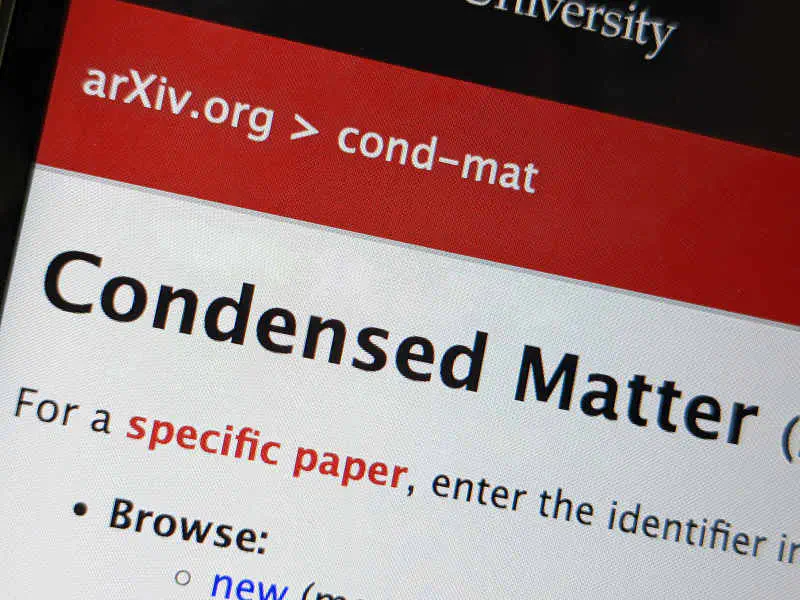View from the arXiv: May 9 - May 13 2022
A summary of new preprints appearing on arXiv during the week of May 9th to May 13th 2022

Welcome to ‘View from the arXiv’, where each week I’ll put together a short list of new preprints which have appeared on arxiv.org during the week which I’ve found interesting. I’ll focus on the categories ‘Disordered Systems and Neural Networks’, ‘Quantum Gases’ and ‘Strongly Correlated Electrons’, and in particular the first two as these are the main areas of the arXiv which I follow. This is an entirely subjective list of things which appeal to me, and of course there are far too many interesting papers to be able cover all of them so I just choose one or two from each day to highlight here. As these are all preprints which have not yet been peer-reviewed, remember to take any claims and conclusions with a grain of salt and be sure to cast a critical eye over the work if you’re interested in more details. (And let’s face it, this caveat should be applied to any published work too…!)
You can also subscribe to this as a newsletter if you’d like it e-mailed to you every Monday morning!
May 9th
Quantum information spreading in random spin chains with topological order, by Takahiro Orito, Yoshihito Kuno, and Ikuo Ichinose: The dynamics of quantum information in many-body systems is something of a hot topic, as understanding how information spreads throughout a physical system can offer complimentary insight to studies of other dynamical observables such as correlation functions or density/spin imbalances. This work looks at random spin chains which exhibit distinct many-body localised (MBL) phases with topological order (known as spin glass MBL and paramagnetic MBL), and investigates how they can be distinguished from an information theoretic point of view. It’s a challenge to study this sort of thing in a disordered system, and although the system sizes here are small (presumably using exact diagonalisation), the results are pretty interesting, and provide a nice connection between MBL as a fundamental phenomenon and ideas of harnessing MBL as a platform for quantum technology, where the language of quantum information is the natural way to describe the system.
May 10th
Multipartite entangled states in dipolar quantum simulators, by Tommaso Comparin, Fabio Mezzacapo, and Tommaso Roscilde: Quantum entanglement is one of the most important concepts – and indeed, resources – for modern quantum simulation and computation platforms. Figuring out robust ways to generate and manipulate entanglement is a major focus of near-future quantum technologies. In particular, a specific and rather specialised type of entanglement known as ‘certifiable multipartite entanglement’ is regarded as highly desirable for technological applications. This paper shows how this type of entanglement can be obtained in two-dimensional arrays of diploar qubits. What I found particularly interesting was that the way the entanglement is produced - time-evolving a generic, non-entangled initial state with an interacting Hamiltonian - should typically result in thermalisation, as the model is non-integrable, and yet at least up to quite long times, this system avoids its inevitable thermalising fate and instead ends up in a very non-trivial entangled state. It’s an interesting setup, and I’d be very curious to know more about how thermalisation is avoided (at least temporarily) in this system.
May 11th
Optimal compression of quantum many-body time evolution operators into brickwall circuits, by Maurits S.J. Tepaske, Dominik Hahn, and David J. Luitz: The building blocks of quantum computers are quantum bits – qubits – which are used to store quantum information. Computations are performed by acting on qubits with objects known as gates, which can be used to entangle qubits or otherwise change their states. Modern quantum computers, though, are noisy and subject to decoherence and other sources of error, which means that there is only a limited number of manipulations that can be performed before the noise and errors take over and the information is lost. This paper considers ways to optimise quantum operations by figuring out how to shrink the number of gates required to perform operations, thereby making the most of the limited number of gates that can be applied before the fidelity is lost.
May 12th
There were very few new papers out today, and unfortunately none of them caught my eye…!
May 13th
Exploiting symmetry in variational quantum machine learning, by Johannes Jakob Meyer, Marian Mularski, Elies Gil-Fuster, Antonio Anna Mele, Francesco Arzani, Alissa Wilms, and Jens Eisert: As the drought of cond-mat papers continues, today I’m dipping into quant-ph to report on an interesting work harnessing symmetry in quantum mechine learning techniques. As I understand it, the point here is that if you take an image of a cat and rotate it, the image is still of a cat, and even though the pixels now appear in different places on screen, the content of the image is the same. This is an example of rotational symmetry. If a machine learning algorithm is smart enough to understand that rotating an image doesn’t change its contents, then this means that the algorithm doesn’t need to be trained on pictures of cats at all possible angles: it only needs to be trained on pictures of cats at one angle, and it can figure out the rest from there. This work is, of course, much more complicated, but the idea is that any quantum machine learning method which can harness such symmetries can be trained and deployed more quickly and efficiently than models which do not make use of symmetries in the data. This is a neat bit of work, even to non-specialists like me, and for more I refer you to a Twitter thread by the lead author. (Full disclosure, I work in the same group as most of the authors of this work!)